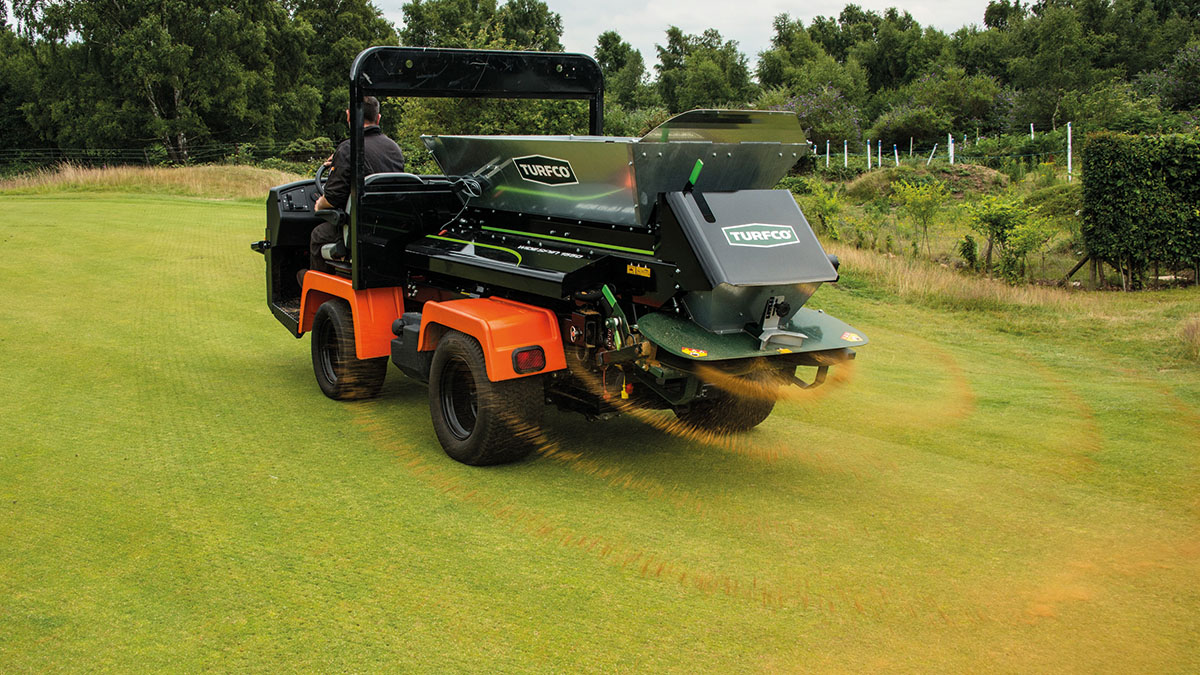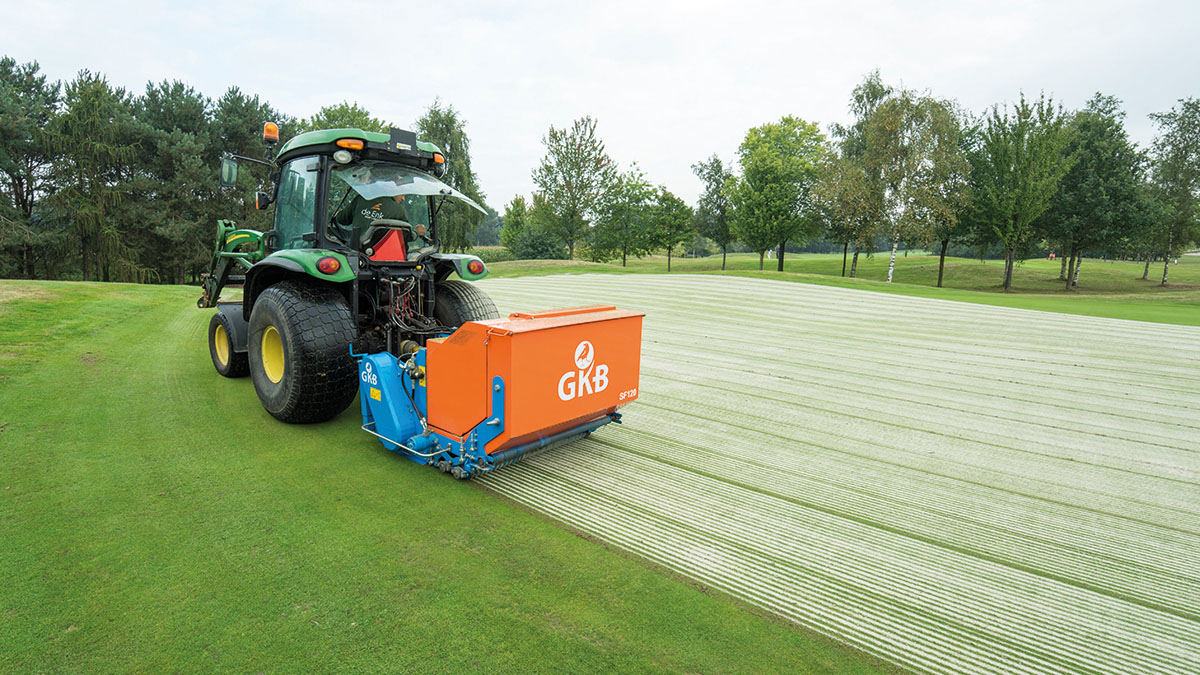- Homepage
- News and Features
- The science behind topdressing
The science behind topdressing
This article was featured in the Spring 2019 edition of Your Course magazine
It’s a vital practice but a controversial topic for golfers. We’ve gathered a quartet of greenkeepers to reveal how and why they topdress their greens.

The sight of sand falling onto a green makes the golfer’s heart sink. We all know it’s necessary but we also know that it’s going to make putting a lottery for a brief period while it settles into the surface.
But if topdressing is so important, why does it change from club to club, with some seeming to do it all the time and others only a couple of times a year?
We asked four greenkeepers to reveal their topdressing tactics.
What is topdressing?
A layer of sand or a mixture of sand and other materials is spread across the turf. There are many different ways of applying it and, depending on the course, greens teams could use it little and often or heavy and only once or twice a year.
The aim is to dilute the layer of organic material, known as thatch, that sits between the surface and the soil, improve the quality of the soil and drainage and maintain a smooth and true putting surface. All of this promotes a better grass plant and means a better putting surface.
We talk about topdressing alongside aeration, which is punching holes into the turf to replace soil air with atmospheric air, because they can take place at the same time.
If the greens have been hollow tined then whatever is in the topdress mix can be integrated into the soil through the holes in the surface.

Paul Oliver, Mid Sussex Golf Club
We use a fairly traditional approach to topdressing our greens. Our annual aim is to work 100 tonnes of sand into the profile between April and October.
We have two maintenance windows to make the most of, the first of which is at the end of April. That allows us to get a large proportion of the 100 tonnes into the profile at each end of the season, by means of hollow coring or solid tining.
We have our second window at the end of August or beginning of September, which allows for a quick recovery due to soil temperatures still being high.
Our maintenance programme during the playing season includes verti-cutting once a month, then dressing straight after to fill any imperfections created by the blades. We also pencil tine monthly. This creates minimal disturbance when the course is at its busiest, while enabling us to work seven or eight tonnes into the putting surface to keep it firm and true.
We use a medium sand dressing with 65 per cent medium sand content, 30 per cent coarse sand content and five per cent fine sand, which ash the same particle distribution as our USGA greens.
Colin Hopper, Elsham Golf Club
My tactics with regards to topdressing has to be the little and often approach. Although there are arguments for both, we can integrate a substantial amount of sand into the upper profile without disrupting play or the quality of the putting surface.
The main reason why we can use that approach is we are fortunate to have the right equipment to achieve our aims. The two vital pieces of equipment we use are a ProGator and top dresser attachment, along with a sweep and fill brush. This allows us to apply six to 10 tonnes of sand on a two to four week basis, dependent on weather conditions and amount of play.
With these pieces of equipment, the process can be carried out in under three hours before golfers arrive at the course. In 2016, we applied 120 tonnes of sand onto the greens with around 80 tonnes of this in the playing season. Using this approach we are managing to keep our organic matter levels in the top 20mm in the four to six per cent range.
We are also fortunate enough to own grinding equipment. With regular sand inputs, mower blades are likely to become blunt so, within a couple of hours, the cutting units are sharpened to produce a quality cut again.
Nigel Thompson, Lilley Brook Golf Club
We are trying to apply around 100 to 120 tonnes of sand onto our greens. When I joined Lilley Brook, I inherited greens that had a very high thatch content.
As a club, we decided to tackle the situation with a new greens programme and we have also installed drainage in our greens. Since we started the renovation works, I basically put two weeks in the diary for greens maintenance.
Ideally, I like to get my first week in around the end of March or early April and my second spot in the second week in August.
During the first renovation, I hollow core around three inches down and scarify to around 15/20mm deep and then apply a heavy dressing of sand – around 40 tonnes.
In August, we hire in a Graden sand injection machine, along with 40 tonnes of kiln dried sand at a depth of 25m. Since we have carried out the major works on our greens I also apply small dustings of sand after a verti-cut and scarify and also solid tine.
With the additional work of topdressing, these greens have been transformed, which is very pleasing. The members are seeing great results and we have the majority of them on side when it comes to renovation works.
Bob Mackay, Murcar Links
We have religiously topdressed with pure sand for the past six years and intend to do so for many years to come.
The removal of organic material was a priority and the decision taken was to heavily sand to fill up the resulting holes with a more free-draining material.
As time went by our surfaces began to firm up, we started to reduce the quantity per application but increased our frequency.
Depending on weather conditions, we will normally start with light fortnightly dressings as early as the end of January and increase to weekly by the end of February. We then continue this procedure until early June, by which time we have produced a firm, true and consistent surface for the season ahead.
Only after autumn renovations to our greens, whether that is hollw-tining or verti-draining, do we now apply a heavier dressing. The little and often process undoubtedly suits our requirements best. We have extended our sandings to our tees, approaches and fairways and, in an ideal world and if the resources were available, we would extend the frequencies to these areas also.
How does your club approach topdressing and aeration? Speak to your greenkeeping team to find out more
Tags
Author

